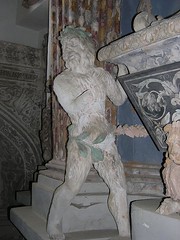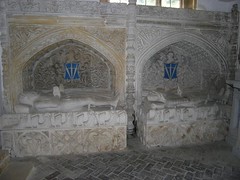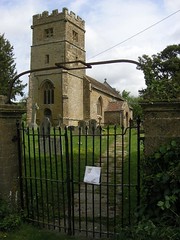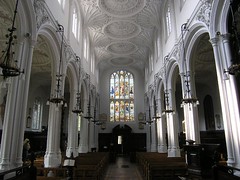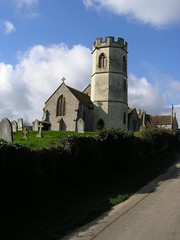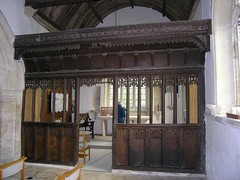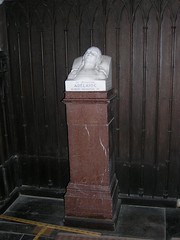Sunday, January 20, 2008
St George, Hinton St George, Somerset - The Wild Man
St George, Hinton St George, Somerset 5/7
All Saints, Lopen, Somerset
St Michael, Seavington St Michael, Somerset
St Mary, Seavington St Mary, Somerset
After all that fuss the church was a crushing disappointment inside - I question whether the CCT would accept it for vesting if it was offered today. We returned the key - I made cbn knock the door to make sure!
St Mary, Kingstone, Somerset
St Andrew, Dowlish Wake, Somerset
The church was largely rebuilt in the C19, but reusing old bits and setting a few puzzles for us. However much of interest inside and some excellent stained glass. Nave, central tower and chancel, with north aisle to the nave, and north aisle/chapel to the tower and chancel. Odd blocked north tower arch with a huge lancet opening into the north chapel. Between chancel and chapel a large tomb chest with effigies to John Speke and wife, all terribly recut, as the the C14 effigy of a lady in a cusped recess in the chapel. Also here is the man that found the source of the Nile, John Henning Speke d1864, a rather pompous black sarcophagus, back plate with inscription under an arch and a bust of the explorer who carelessly shot himself in the hip whilst out with his cousin in Wiltshire and died aged 37 15 minutes later. Some classy C19 fittings, also a much worn second font from West Dowlish church which was demolished c1700, Norman (although the church guide says Early Saxon) with remains of blank arcading around the bowl. [other pics on flickr]
St Mary, Donyatt, Somerset
St John the Baptist, Chipping Barnet - Butterfield's new church
St John the Baptist, Chipping Barnet - the old C15 nave
St John's Church stands in the fork of the main road at the top of the hill from the stadium at Underhill and the station, and from here appears entirely C19, and I guessed the work of William Butterfield (which it is!).
However this is a medieval site, and Butterfield added a new nave chancel and south aisle onto the existing medieval church which survives as the north aisle and outer aisle. The former west tower and chancel were pulled down, and a new tower built at the west end of the Victorian nave. The north arcade is the Perp. south arade with the clerestory above now unglazed and entirely an internal feature. It survives on the north side and the church was not a bad size before extension.
Some stone fragements are built into the new tower and in the south chapel is a splendid canopied tomb chest and effigy to Thomas Ravenscroft d1630, the figure carved from a single block of pink alabaster. Elaborate vaulting to the canopy.
London St Mary Aldermary 2/2
London St Mary Aldermary 1/2
Saturday, January 19, 2008
Easton Grey, Wiltshire
A mainly Forest Crawl - 7
At the opposite end of the village to the castle. Tall slim unbuttressed tower and tall stone spire, the bell openings in the spire lowest stage. The rest of the church appears rebuilt from outside, but the chancel east window of what is essentially a two naved church (nave and north aisle) is handsome C15 Perp. The key to this church can be obtained from Jolley's Shop in the village which is by the entrance road to the castle, unfortunately you have to get into the church porch before you discover this! So now you know in advance!
As light was beginning to fail I called it a day and headed back home pretty much the way I came.
A mainly Forest Crawl - 6
ALL SAINTS, BISHOPSWOOD, HEREFORDSHIRE
is oddly sited high above its village in the middle of the woods. Dating only from 1845, it has lancet windows and an odd sideways facing south bell cote on the gable of a central outer bay. Sadly it was locked.
I then detoured to look at the remains of FLANESFORD Priory, which were long used as farm buildings, but are now holiday appartments.
I next detoured again for 90 minutes to visit the ruins of GOODRICH CASTLE, perhaps my favourite castle. Sadly the feature I found most memorable from previous visits has had to be restored in the last year. It is a huge column, dividing an arch in the Solar into two bays, which has had to have a bit of flooring inserted around it to provide additional support (and stop masonry falling onto visitors below!) ; the column and the spandrel above do seem to have much new
stone. Still better this than the arch and column to fall.
A mainly Forest Crawl - 5
By Henry Woodyer, but he has kept his quirky style pretty much in check here. Tall west tower with saddleback top. Inside wide and spacious. Seating now blue modern upholstered chairs arranged in vaguely curved rows on a crimson carpet.
A mainly Forest Crawl - 4
An enormous churchyard, and a sizeable church, closed for major restorations - but the door open and I was able to look inside. Nearly all features and furnishings swathed in opaque plastic, lots of plaster stacked, and work very much in hand. Fabulous east arch of the Norman north arcade may be the original chancel arch reset. The present chancel is Victorian and incorporates a former crossing (W, N and S arches only). A revisit will be necessary!
A mainly Forest Crawl - 3
Late C12 church gathered around a central tower. The exterior is unattractive, thanks to the rendered walls, and the interior too lacks appeal. North and south arcades, the west three bays on the north blocked, and the remainder screened off by curtains and perspex partitions to make a chapel in the remaining part of the aisle. Bizarre arrangement of stone pulpit hanging from the tower stairs (NW crossing pier). Besides its main organ, this church has a harmonium. Not unusual maybe but this harmonium has a little set of organ pipes! My favourite feature was the east window glass in the chancel, which Brooks feels is likely to be the work of Wailes - lots of deep blue and a depiction of Golgotha and the three crucified men, the city behind, and a busy crowd scene of mainly Roman soldiers.
A mainly Forest Crawl - 2b
Wide nave and equally wide aisles make the interior exceedingly spacious. This spacial feel is increased by the Victorian clerestory and steep-pitched main roof. In comparison the chancel is much lower, and the dominant east window is also C19 and recalls the west window of Tintern Abbey in the valley below. The church posesses a number of monuments from the C14 onwards. Most famous is the Dean Miner brass, set on an altar tomb with two more conventional brass figures of the mid C15. There is also an incised slab with the figure of an Archer, complete with bow, and probably C17. Several tomb chests with effigies, many sadly worn or damaged. In an odd outer south chapel Sir Edward Probyn d1742, a standing monument, largely architectural and inscription, but with a rather smug-looking bust of this gentleman with long curly wig. I think the middle bit (sarcophagus to his nephew John Probyn d1773) has been inserted between bust and epitaph. The bust is shown wearing chain of office of the Exchequer, which the inscription records he was Lord Baron of the Court of the Exchequer.
A mainly Forest Crawl - 2a
I have never been here before, and for some reason I thought it was in another part of the Forest, not where it is high up in the hills on the eastern side of the River Wye. This is the self-proclaimed Cathedral of the Forest, a large and most unusual church. The tower is bulky and in outline impressive with a good parapet and pinnacles to finish it all off. Yet bizarrely the bell openings are all placed a little higgledy-piggledy. [continued]
A mainly Forest Crawl - 1
I was intending to cross of my list three churches which have bugged me for years in not visiting.
ST PETER, CLEARWELL, GLOUCESTERSHIRE
was a revisit - it just was alongside the road, and I haven't been here with a digital camera before. Fancy Victorian by one of the greatest (in my opinion) but lesser-known architects John Middleton, who did a lot of work in Cheltenham. Quite a "town" church design, the tower and spire standing at the south west corner and looking almost like an afterthought! Inside banded red Forest stone and Bath stone create an unusual effect for the arcades and chancel arch. Here is a case for not using flash, the stone appears white, whereas it is in reality an intense cream colour. Lush carving to the capitals, and typically Middleton getting larger and most elaborate in the chancel.
Hamming it up in Somerset - part 12 (final)
Thus ended my day, 12 churches visited, 11 entered.
Hamming it up in Somerset - part 11
An attractive cruciform church with central tower but with no aisles. Heavily restored, making the C14 details rather untrustworthy but these may well reflect what was here before the restorers got to work. The chancel has a hammerbeam roof - or should that be an angel-beam roof, as huge wooden angels lean out into the church. The NE one has her face buried in a stone foliage headstop of the east window hoodmould, as if she was sniffing the flowers! Unusual castellated organ case with flanking turrets in the south transept, completely hiding a piscina and monument recess in the south wall. In fact this area is completely inaccessible and surrounding the organ must be 130 years worth of cobwebs.
Hamming it up in Somerset - part 10
A simple church which has been extended piecemeal over the years. Pevsner makes no mention of its most surprising feature, a passage-squint complete with its own little window! Nothing to detain you long here, but a pleasant little church nonetheless.
Hamming it up in Somerset - part 9
Unlike Low Ham (below) this church does make Simon Jenkins's top 1000 and probably this is just about deserved as well. In a county of towers, the short dumpy tower here is a disappointment but no so the C15 rebuilding of the church. Clerestory, nave and chancel have a superb collection of gargoyles wrapped around angles and on one occasion quite rude! Lofty interior with another fine Somerset roof in the nave and here in the chancel too. Excellent tall C15 rood screen.
Hamming it up in Somerset - part 8b
Hamming it up in Somerset - part 8
THE CHURCH IN THE FIELD, LOW HAM
No dedication is recorded for this church which was rebuilt in the C17 and now known as above. Still Gothic, with short lofty clerestoried nave and lower chancel. Opening the original door and you are immediately confronted with another doorway in an ornate Gothic screen; this screen was removed from a similar position at St Mark the Lord Mayor's Chapel in Bristol when that church was restored. Small stained glass figures flank the double doors and go through these doors and the church rises full height, a wonderful sight. The arcades look authentic work, matching the local style (could they have been reused?). At the east end of both aisles grand monuments. To the north Sir Edward Hext d1623 and wife d1633. White stone, superbly carved effigies, on a rather plain chest. The railings around are also original. By it on the east wall excellent carved Royal Arms. To the S Sir Ralph Stawell d1689 completely architectural, with two putti flanking the inscription below and around very ornate ironwork railings also original. The rood screen is still Perp in style and recalls many of the fine screens around but is turning classical in part. Charming little angels clutching texts below the main inscription. The seating and the pulpit also of the period as is the glass in the east window.Unbelievably this church does not make that much maligned volume "England's 1000 best churches" by Simon Jenkins. Come here - plan your day around seeing this unique building - it is a stunner.
Hamming it up in Somerset - part 7
ST JOHN THE BAPTIST, PITNEY
has been largely rebuilt but the tower is original and there is a squint from the south transept deep enough for three cross ribs. Medieval font, Jacobean pulpit and reader's desk. The church stands on a steep slope and appears to be almost built into the hillside.
Hamming it up in Somerset - part 6
was my revisit, and I felt a little tearful as I remembered being here with Mum. I believe I sat in the same pub and even at the same table for lunch as we did on my last visit here.
The church is larger than I remember it, wide nave and aisle, transepts (well south tower transept) and chancel. It is largely C13 and early C14, gone over in Perp times, trying to be swagger but apart from one feature failing. That feature is the awesome C15 roof to the nave, with mystical beasts (almost Chinese dragon-like) instead of tracery above the tie-beams, and close cusped panelling etc. Other random points - the tower has an octagonal top stage, big bulky pulpit dated 1615, chancel narrower than the chancel arch.
Hamming it up in Somerset - part 5
ALL SAINTS, KINGWESTON
was rebuilt in 1855 by C E Giles, and he has produced an ornate design of nave and chancel, with a dominant elegant south porch steeple, starting square and turning octagonal. Truly my "find of the day". It is all the more surprising to discover under this tower, a large C12 Norman doorway.
Monday, January 14, 2008
Hamming it up in Somerset - part 4
is dwarfed by its neighbours - to the west The Court, a neo-Tudor building now four appartments, and a tree - probably a pine of some sorts but I am no expert! C14, cruciform, with a central tower (vaulted inside). Extended twice by J C Buckler to the north, the aisle with windows under their own gables, and another full transeptal bay. He restored the rest and all but rebuilt the chancel. Original is the impressive six-light west window which incorporated the west doorway. The interior is a bit of a long low jumble, with the best bits the Victorian extensions and the chancel.
[postscript - the tree is a Wellingtonia apparently]
Hamming it up in Somerset - part 3
Be warned - Church Lane here does not take you to the church! The approach is from the east, and the church is a rarity, one built all in one go in C15 Perpendicular. Two east gables made me suspect an aisle but this is an illusion. The principle feature outside is the bizarre early C19 ironwork weather vane on top of the shallow pyramidal roof of the tower, something I managed to chop off in most of my external snaps! The sound of J S Bach could be heard outside, and inside I was treated to a free recital as I looked around. This always makes me linger and see more but there is plenty to see, if you accept that nothing here is of "top" quality. The south door starts it off, C15 ironwork with an original sanctuary knocker on a multi-studded medieval wooden frame. Most of the pews are original too, and one has a little fold-out seat, another with an alms box on a paneeled square pier. The roof above is also original, a ceiled wagon roof with ribs and bosses, and there is a ceilure over the east end. The pulpit is stone, C15, like the font. The tower screen has a balustrade which may be the former altar rails (these appear Jacobean). Similar roof in the chancel embellished by female figures holding shields - if these were angels then their wings have been clipped. Piscina in chancel with traces of colour, and an aumbry opposite with an original door. Back outside and the churchyard cross, now C19 incorporates a medieval depiction of the Crucifixion.
Hamming it up in Somerset - part 2
stands in a not particularly attractive village with many new detached houses seemingly dating from 1930s to 2000ish. The church is not large but has an unusual octagonal tower at the NE. The north porch shelters a Norman doorway, most else is C13-c1300 apart from a few Perp windows. Both transepts are now screened off to create rooms. All details seem totally renewed to me to the point of tedium, and there is a dearth of fittings too. The pulpit looks late C17. The best feature is the one which hasn't been recut, a small statue of St David on the shaft of the churchyard cross by the porch, but sadly very worn.
Hamming it up in Somerset - part 1
My Crawl took me to mostly first-visit churches (bar one) and to open doors (bar one, or two to be more correct).
I took the A37 to the point where I finished two years ago at Lydford. Turning right at the crossroads brought me to the odd little church of
ST MARY MAGDALEN, KEINTON MANDEVILLE
It merits four and a half lines in Pevsner, and seems to have been the subject of a recent restoration, perhaps in celebration of the Millenium. The LychGate, churchyard paths and walls are all new, as is the small room in the NW corner of the church. The chancel is C13, with a single lancet as an east window, but the rest seems c1800. The tower could almost be built out of Lego, and has a bizarre
NE stair turret projection about half the size of the tower itself!
The church was locked but four keyholders were listed - phone only. Now I did get annoyed, but probably on reflection more with myself, cos I turned on the phone only for it to flash Battery Low - Please recharge! before turning off. Nevermind I had spotted the rectory - but here too I was disappointed to find that it was rented out for 6 months to people who didn't have the key, nor a sniff of it.
Hoping this was not going to be the sign of things to come I carried on with my planned targets for the day.
A long lunch in Wiltshire - part 4
A large church, with much of interest, not entirely obliterated by the Victorian restoration. Long nave and chancel, with SW tower and south aisle and chapel in one. South and north porches too, the latter disused, but open today thanks to the cleaning ladies which turned up enabling me to get a glimpse of a C15 image niche above the internal doorway. The south doorway has cusping to its arch, C14. The tower is late C17 or C18, still attempting Gothic. Inside a Norman tub font with crude blank arcading and two fine screens with single light divisions, C15, but that in the south aisle still with coving and cresting above. The roofs are also largely original, C14 in the aisle and C15 in the nave.
I am not a fan of internal re-ordering and the removal of pews but I have to say that the design here is an example which if repeated elsewhere would win me over. Considerable care has been taken in the nave and aisle which can now serve a variety of functions.
A long lunch in Wiltshire - part 3
is less than a mile away from Draycot, and here is a church cruelly restored and rebuilt, yet with some of the oddest features collected together in one place. I get a sense that the church was perhaps much grander at one time, and sadly the main parts of the church are Victorian. Very wide nave may be an incorporation of a former north aisle, as the chancel is off centre, and in alignment with the
Victorian south arcade. I do not question that the latter is C19 (it replaced a Doric arcade apparently), but it is also not in line with the tower (which is also off centre to the nave) which seems to have been built into the nave and a small thin arch connects it up to the arcade. On the west wall is a very large Green Man respond, which has probably been retooled and surely original C14. Similar birds in foliage as at St Mary Redcliffe in Bristol. Outside this aisle has much use of ballflower ornamentation in the windows and in a moulding
starting by the tower, arching over the west aisle window and continuing along the south wall above the windows. The east window of the aisle has squashed reticulation tracery, and the foot of the middle light is blocked with an internal image niche and outside a repeat blank representation of this window as seen from inside with flanking niches (only fragments of the south niche actually survives inside) and the central niche!! The interior of the aisle is
far more satisfying than the nave and chancel. Here too a Norman font. The north wall of the nave has handsome Perp square-headed windows, possibly reset from the nave north wall or if in situ the former aisle wall. Perp too and vaulted with cross ribs is the south porch. The final quirk is on top of the tower, also Perp, with an ornate panelled embattled parapet and corner pinnacles, but placed
centrally is also an ornate turret, where a spire might sit and like you might see further west near Bristol but atop the stair turret in an angle position. Take a look too at the odd former rectory SE of the church, Gothicised.
A long lunch in Wiltshire - part 2
gives its name to the benefice (of Draycot), but is the only one of these church not in use, being vested in the Churches Conservation Trust. It is also the only one I found locked today but the key readily available from a house in the tiny village Draycot Cerne at the end of a no-through road. The church however is not here, standing in landscaped grounds by a lake (actually a dammed stream) below
Draycot House, and reached across a low bridge over the lake. (None of this mentioned in BofE yet the house looks very large, and in core looking C17 to me!). It has an air of gentle neglect, just as it did when I was here last, a few weeks before it became redundant. Tower, nave and lower chancel, and a north transeptal family pew/chapel opposite the south door of the nave. Inside fittings are nearly all of a period, Gothic, and earliest Victorian with matching panelling. Unusually the chancel is lower than the nave - I mean the
floor actually, three steps lower. The nave floor also seems to slope slightly towards the chancel arch. The tower is completely filled by the organ. A collection of monuments in the north chapel, the usual swagger of the local gentry. A dark brown pedestal supports a sleeping child - Adelaide Cowley d1843. More interesting in the chancel is a tomb recess with a cross-legged knight, a grand early C16 tomb chest north of the altar, and if you move the mat in the centre of the chancel you will see Sir Edward Cerne d1393 and his widow d1419 holding hands in a good memorial brass.
A long lunch in Wiltshire - part 1
Yesterday I had the unusual day which started and ended with a meeting in Chippenham, one 9-12 and the other 3-5. I also have built up many hours of "time owing" so what better thing to do than kill time with a few churches?
All the churches I visited today are in the same united benefice.
ST PETER, KINGTON LANGLEY
has no real history but was built as a victorian chapel-of-ease, and is now a parish church. It dates from 1855-6, a simple nave and lower chancel with lancets and a bellcote over the west gable.
Lunch taken at the Hit and Miss Inn here - lovely!
Yesterday - all my troubles seemed so far away! part 9
The Norman church par excellance, three-celled - nave, chancel, apse, so often photographed in books, was my overall destination today. I could have rushed in and gone quickly and missed so much. If you come spend some time here and the building works its magic on you. Here is some of the best C12 figure carving in the country, including a complete corbel table around the outside - some humerous, one enchanting (a soppy dog and a hare) and a couple very rude (including a sheila-na-gig). The doorway into the church is sumptuous and include stylised slim figures like those seen in Spain e.g. at Santiago. These figures appear inside on the chancel arch, but are figures of saints - including an evident St Peter with a key on the north side. For this church, the font is truly enormous and stands under the little Jacobean west gallery. January and I had the church to myself. [I found the church open]
To the west is a large motte and bailet castle. On the motte remains of a shell keep, and the best view of the day across the countryside towards Hay Bluff. The sun was low and I decided that this was the place to end the ChurchCrawl.
Yesterday - all my troubles seemed so far away! part 8
A rather strange looking building, thanks to the Victorian roof with dormers on top of the low broad west tower. Nave with south porch and north aisle, and chancel with Victorian vestry to the north. The nave is Norman - see the small slit window west of the porch and the plain stepped chancel arch. This church had the best collection of monuments on this outing, including a strnge old gent with a long beard, the end of which is held between his praying hands on his
chest! The SE corner has a "kneelers" monument with a large number of named children below (two more names than figures, one of each). The Jacobean pulpit unusually sits on the floor. [I found the church open]
Yesterday - all my troubles seemed so far away! part 7
A large medieval church, presumably unroofed after a new church was built some way to the west in 1864 (which I did not see - oops!). If my visit was a guide, then the reason for the abandonment of this church was damp, as large parts of the churchyard were filled with water and underfoot the ground was boggy. I entered the churchyard by jumping over the wall and entered the church itself via a window as both lychgate (in part medieval - most rare?) and porch had a
couple of inches of water gathered on the stone flags. Not much to see (remains of an early C17 hanging monument) but a charming ruin nevertheless. My impression is that the ground level inside the ruin has been raised and yet was still very wet. (Yes I know, no roof - bound to be!)
Yesterday - all my troubles seemed so far away! part 6
If it were not so famous, then this church would have been the complete shock of the day. Stuck on a Herefordshire hillside looking out over the River Wye is an Italian Tuscan church, a humble church of the 1840s (the current nave structurally) was transformed by the addition of a campanile and cloister walk running along the south wall of the church. It turns into an atrium on the west wall and a porch in the NW corner. If this isn't enough then to the south is a
mature Monkey Puzzle Tree (well that's what I have always called them). Inside is jaw-dropping, because within the east end of the church Seddon has created an almost Byzantine effect by introducing four piers with absurdly large carved capitals, to create a crossing and transepts effect. The east apse glistens with a golden mosaic fresco. In actuality the parts are ugly, but the sum of the
parts is astounding, and quite unlike anything you would expect in the English countryside. [I found the church open]
After a very late lunch (1.50pm) in one of Hoarwithy's two pubs I moved inland onto the hills to the west of the River Wye.
Yesterday - all my troubles seemed so far away! part 5
ST TYSILIO, SELLACK, HEREFS
like Foy, is close to the river, and has a spire that seems to rise up
straight from the ground, although there is actually a tower which barely reaches the roofline. The belfry windows are in the spire itself. Ice covered the road (the little stream was full to the top and probably had flowed briefly over the road, and the sun was just appearing over the hill here. The church is strange in plan, caused by a large C19 N transept which opens into the nave with a two bayed arcade. To the west one bay of a former aisle with a Norman pillar, almost cut off from the rest by complicated seating arrangements and possibly
once a family pew. To the east a vaulted single-bayed chapel. No structural division between nave and chancel, just a prettier bit of roof!. The south wall of the nave has two large windows which are treated like dormers either side of the large porch, one lighting a west gallery on which is the organ, and the other (with a medieval panel of glass showing the Crucifixion) lighting the pulpit and tester, a grand Jacobean piece. Both the west bay of the aisle and the transept have a single grand C17 and C18 memorial respectively. The glass in the east window is equally important, a complete survival from 1630, reusing some olde fragments. And here is the explanation of the window at FOY which so impressed the people at the manor there that they ordered a copy of this window for their church some 40 years later, including the tracery. Reading what I have written suggests a very disjointed and confused building. Yet it all hangs together and I found it quite charming and the unexpected highlight of my day. [I found the church open]
Yesterday - all my troubles seemed so far away! part 4
was my first planned target, chosen because I had belived that I had spotted a wondrous spired church here whilst on a school trip to the area. It wasn't this one but the church is pleasant enough and its setting is enchanting, on a tall bank overlooking the River Wye a little to the south beyond the saturated meadows below the churchyard.
You have to want to come here, as it stands at the far end of a huge river loop and you can go no further. Tower, nave and chancel, the entrance from the north, not via the porch on the south side where the views are to be had. Inside much of interest, a C17 pulpit, a fancy screen of a similar age (heavily restored) which incorporates parts of an earlier loft with small carvings, my favourite of a hedgehog or wild boar no more than five inches across. In a cusped recess by the pulpit (presumably once an altar recess) is a small C13 effigy. The glass in the east window is dated 1670. Come here - the setting alone repays, but the fascinating contents will detain the church enthusiast as well. Be warned though - no pub here.
Yesterday - all my troubles seemed so far away! part 3
I discovered that Ross has a lovely eastern by-pass to the M50 and I quickly gotonto the other side of the River Wye, which was full and swiftly flowing. Takingthe Hereford Road I immediately turned off to my first target and wasimmediately seduced into stopping by
ST BRIDGET, BRIDSTOW, HEREFS

ST BRIDGET, BRIDSTOW, HEREFS
Originally uploaded by ChurchCrawler
Apart from the tower, this church looks entirely rebuilt, but it is on a grand scale, especially for somewhere with so few residents. Four-bayed nave and aisles and chancel with north chapel/organ/vestry. The church was locked, but with phone numbers to contact, but this was not an intended target for the day so I was walking back up the path when a lady driving by called out to me. She had the key! The church is usually open daily from Spring to Autumn I was informed. I was left in the open church to take my photos. The surprise inside is the large and ornate chancel arch, Norman, and a strange shrine in a recess on the north side of the sanctuary. Sadly a credence shelf is fitted immediately above making appreciation of the carving on the top very difficult.
Yesterday - all my troubles seemed so far away! part 2
ST LAWRENCE, WESTON UNDER PENYARD, HEREFS
Tall C14 tower, the rest all rather over-restored and long and low in contrast to the tower. The porch may contain medieval timbers but lacks character. Inside is a reworked Normn arcade, the chancel is EE and the aisle itself C14. Not a great deal to really enjoy - some animal head stops to the arcade hood moulding, a couple of Georgian memorials (the best to James Rudge d1808, with a less than expansive inscription, a relief above showing a man cradling another fallen, and a tethered horse behind ; above half-kneeling presumably the deceased, a late example of this motif) and two fonts. [I found the church open]
Yesterday - all my troubles seemed so far away! part 1
Just after 11am I was rattling the door of a church I always seem to drive past and never visit in my hurry to get somewhere further on! Not today.
ST SWITHUN, HEMPSTED, GLOS stands on a small hill above the flood plain of the Severn, which from the look of things could be very handy in the next few days given the amount of standing water in the fields. A simple church, nave with south porch, central tower (like
many others locally in Gloucester) and chancel, all late C15, with a touch of the C19 in the lengthened nave and N vestry. Inside a Norman font, a largely medieval panelled ceiling to the nave, and a fine tomb chest with painted effigy of Judge Atkins d1610 in his robes, one hand clasping a scroll. [I found the church open]
Reached by a footpath from the churchyard is a C14 well house, but local dog-walkers said I would need boots as it was very muddy - so will have to wait for another day.
